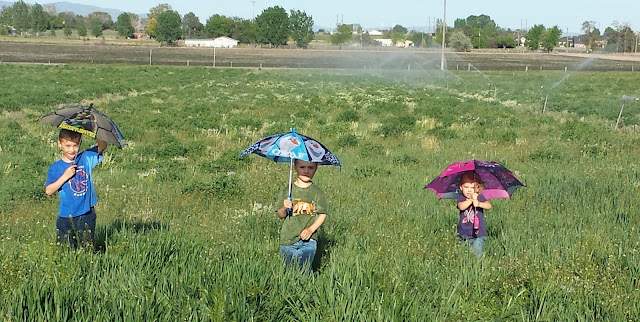In the life of a farmer, irrigation systems are both a blessing and a curse. When they work the way they're supposed to, they can make your life much easier. When there is a problem, however, it can cost a lot in both time and money to get the problems rectified and the water flowing again.

A few weeks ago my family and I went out to the field to work on getting the wheel lines straightened up and ready for irrigation season to start. A wheel line is an aluminum sprinkler line that has a 5 or 6 foot tall metal spoked wheel on every 40 foot section of 4 inch pipe. In the center of the line there is a mover, which is a metal frame mounted on 4 wheels with a 6 to 8 horsepower motor that will roll an entire 1/4 mile line back and fourth across the field. They work well, are easy to move, and grow excellent crops. Wheel lines have but one [giant] flaw. They do not travel straight. Even if they are exactly perpendicular to the main line (which supplies the necessary water) a slight slope or gradual hill somewhere in the field can cause the entire line to shift one way or another and become crooked. If the proper steps are not taken to straighten the line and get it to follow its tracks when it comes back across the field again, two things can happen. After going back and fourth across the field a few more times it can move so far away from the main line that the hose or pipe used to connect it will no longer reach. It could also get a bow in the line that becomes so crooked one of the pipes will break under the pressure.


While we were in the midst of straightening out the above pictured wheel line and re-attaching the end pipes, the thought crossed my mind that fixing a crooked wheel line is a metaphor for life.
Often times we can see where we want to go in life and we may even see how to get there. It can even seem like a simple and easy path to follow to reach our goal. But, like a wheel line moving across a field, as we travel an unexpected bump in the path can, over time, throw off the whole journey. If you ignore the bumps in the field and challenges you need to face in life, they will only become larger problems that will be harder (and more costly) to deal with later on. They might even make it impossible for you to get to where you want to go.
So, how do you get a wheel line (and your life) back on track and headed in the right direction? When you notice that the line is starting to go off course, you steer it back to where it needs to be. Starting at the mover, you walk down one side of the line and move each wheel forward (or backward) a foot or two. Day after day, as the wheel line continues on across the field, it will gradually move back into its tracks from the previous trip. When it starts to move out of line again, do the same thing again and bring it back to where it should be.
The same approach can be taken in our lives as well. When as a problem or dilemma arises, do what it takes to take care of it right away, so you can move on. Then you move on. Dwelling on the troubles you've had in the past does no good. You look back only to see where you've been and to help you know where you are heading.
If you take those simple steps to keep your wheel lines straight, sprinkler lines (and lives) can travel smoothly and grow some beautiful things as the journey continues.

 |
| A straight wheel line is a happy wheel line. |








































